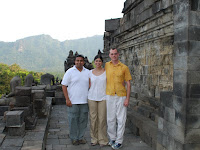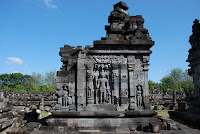
After dealing with endless travel obstacles for two weeks, we found ourselves elated to be finally commencing our much-anticipated trip to Tibet. After changing planes in Chengdu, we began a spectacularly-scenic and not-especially-bumpy northwestern flight over the cloudpiercing Himalayas. In a little over two hours, we made groundfall on the Tibetan plateau, some 3,650 meters (about 12,000 feet) above sea level.
As we deplaned from our aircraft, we immediately felt the palpable effects of the altitude. Slowly ambling toward Lhasa’s lone baggage carousel, we felt as if we were bearing twenty-pound weights around each of our ankles. Nevertheless, clear sunny skies and temperate weather greeted our arrival, and we were pleasantly surprised to discover our smiling Tibetan guide, Phuntsok, standing in the arrivals hall with a discreet placard in hand that simply read “Banerjee.” After enduring three months of signs bearing “Murthy,” Kaberi took it as an auspicious sign of good things to come.
During the one-hour ride to our hotel, Phuntsok shared his background with us and provided a quick orientation to Tibet. Born and raised in Lhasa, Tibet’s capital and most populous city, he had worked as a tour guide for 20 years. He counted among his clients Uma Thurman’s father, a long-time Tibetphile who gave both of his daughters Buddhist names. Phuntsok spoke matter-of-factly, and without emotion or judgment, almost always leaving us to fill in the blanks for ourselves during the conversation.
Over the course of the drive, we inferred that in an effort to more rapidly assimilate Tibet (officially, a special administrative district) into the mainland, the Chinese government was compelling ethnic Han Chinese villagers to relocate to Tibet. As a result of these efforts, Tibetans were now a distinct minority in Lhasa. In a further effort to control foreign impressions of Tibet (again, our takeaway, not Phuntsok’s), the Chinese government was delicensing Tibetan tour guides and replacing them with their Chinese counterparts. Today, Tibet’s tourist economy disproportionately boasted Chinese tour guides and drivers.
Learning all of this did not endear the Chinese government to us, and made us realize that a candid blog entry on the matter would need to wait until we were out of China. We were also enormously thankful to have found an endangered species of sorts, a native Tibetan tour guide (although we do not begrudge the rank-and-file Chinese settlers in Tibet, many or all of whom are just trying to make a better life for themselves and their families).
Riveted by the conversation and the passing scenery of towering, distant sand-colored peaks reflecting in modest indigo streams, we found that the hourlong ride to Lhasa flew by. The Chinese government was rapidly upgrading Tibet’s infrastructure (earthmovers and dumptrucks were seemingly omnipresent) to the mainland’s standards, and the new airport road which at one point tunneled smoothly through a rather sizeable mountain reflected formidable Chinese engineering prowess. As Lhasa neared, Phuntsok pointed out several examples of houses rebuilt in traditional Tibetan flatroof style and we caught our first glimpse of Tibet’s official animal mascot, the yak (which appeared at first blush to resemble a fuzzy water buffalo).
Making our way into Lhasa, it was difficult to distinguish the city from any other Chinese urban outpost. The wide, main thoroughfare was flanked by commercial establishments catering to a Chinese sensibility including boldly-advertised Chinese restaurants, clothing shops and electronics stalls. The sight led Vik to quietly whisper that the Chinese would invariably rule the world, but they would preside over a much cheesier one. Only upon turning down a small, cramped alley leading to our “boutique” hotel did authentic Tibet introduce itself. The smell of yak butter and incense assaulted us as Phuntsok escorted us around one corner and then another full of staring and weathered Tibetan faces.
We had chosen the hotel, the
House of Shambhala, based on lavish praise from the
New York Times travel section and the
NPR website (two sources which provide an unambiguous window into Kaberi’s political persuasion). Situated in the old section of the city known as the Jokhang, the hotel boasted an expansive roofdeck with clear views of not only the proximate street life, but also the prominent mountaintops encircling Lhasa on all sides.
We spent our first afternoon adjusting to the altitude by drinking (on our Beijing friend Werner’s recommendation) copious amounts of hot ginger water and moving around slowly and deliberately. We soon found ourselves shocked and dismayed to discover that the mere act of climbing up three flights of stairs to the rooftop restaurant was the basis for a near hospitalization. Huffing and puffing, with our fast-beating hearts in our throats, we were forced to come to terms with the notion that we were essentially spending the next several days conducting our lives as if we were on top of Mt. Hood.
The next morning, Phuntsok met us with tickets in hand to see the Potala Palace, the Dalai Lama’s former residence, at exactly 10:30 am. As we approached the distinctive structure high atop a central hilltop, we saw masses of Tibetan pilgrims either prostrating themselves before the building or rotating clockwise Tibetan prayer wheels in their right hands. Due to the political sensitivity (pictures of the current Dalai Lama – the 14th of the line – are prohibited in Tibet), admission to the palace was strictly regulated by the Chinese government, which exactly specified both an admission time and a departure time not to exceed one hour therafter. With Phuntsok’s expert guidance, we managed to tour the palace in a cool 59 minutes. This was no small feet, considering the excruciating several-hundred step climb up to the main entrance.
Unable to take pictures inside the Red Palace (the ceremonial wing) and the White Palace (the residential wing), we focused on the experience itself. As we walked from one dimly-lit, but elaborately-colorful room to another, we were exposed to the rich symbolism of Tibetan Buddhism. As conveniently self-described Indians (our U.S. passports were neatly tucked away out of sight), we were charmed by several Tibetan priests who, upon asking Phuntsok where we were from, would smile at us warmly and proclaim India as a good friend to Tibet (by way of context, after cleverly evading capture by the Chinese in 1959, the 14th Dalai Lama was granted refuge by India in Dharamsala, a town located in the northeastern state of Uttaranchal).
Feeling a responsibility to preserve the warm feelings, we always took care to respond to the priests by respectfully clasping our hands together in the traditional Indian
namaste pose. As our tour progressed, it was also quite clear that Tibetans shared a spiritual connection with their southwest neighbor, with several prominent Buddhist teachers (potentially including Buddha himself) emigrating north from India. The act of walking through the home of generations of Dalai Lamas with the knowledge that the 14th Dalai Lama hasn’t been allowed to return there in nearly 50 years made us both sad and angry.
After leaving the Potala Palace, we made a beeline to Lhasa’s outskirts to see the Drepung Monastery before it closed in the early afternoon. Founded in 1416, Drepung once housed over 10,000 monks. After a tractor ride up the monastery’s winding entrance road, we saw Tibetan monks of all ages in their distinctive red attire. We were particularly amused by a couple of young monks who chose to pair their robes with Nike sandals.
Making our way through the monastery complex, we saw the large kitchen where the monks cook (with ample amounts of ghee butter on hand) as well as dark, cramped living quarters. Moving along, we were particularly struck by the beauty of the main prayer area which was adorned with colorful silk banners hanging from the ceiling. We then made our way to the repository for the Tibetan texts, which do not represent complete sets of works, but, rather, only what monks and loyal believers could save from destruction by the Chinese.
Our final stop of the day was at the Jokhang Temple, namesake of the oldest Lhasa district, and the holiest of all temples in Tibetan Buddhism. Our late afternoon arrival (designed to afford us with a few hours to recuperate from the dizzying effects of our otherwise-ordinary physical activity from earlier in the day), translated into sighting fewer prostrating devotees than at daybreak, leaving Kaberi to return on subsequent mornings to take more pictures. At Jokhang, we were disappointed to learn that all of the images and idols had been recreated in the recent years because the originals had been destroyed by the Chinese during Mao’s deplorable Cultural Revolution.
As our first full day in Tibet came to a close, we had a chance to reflect on the previous hours. While we appreciated the scale, grandeur and cultural significance of each of these three Lhasa landmarks that we had visited, we were most struck by the persistent faith and devotion of the Tibetan people in the face of such considerable adversity. It was hard not to be humbled by their spirit and perseverance.
 With a bare minimum of days left in the warm confines of Bali, the three of us rented a private villa for two nights on the southern tip of Bali, near the five star resorts of Nusa Dua. While the villa’s décor left something to be desired, its service level did not, and we thoroughly enjoyed having a private staff at our beck and call. We especially appreciated seeing our clothes magically laundered, pressed with the scent of baby powder and left neatly folded on the bedside by day’s end.
With a bare minimum of days left in the warm confines of Bali, the three of us rented a private villa for two nights on the southern tip of Bali, near the five star resorts of Nusa Dua. While the villa’s décor left something to be desired, its service level did not, and we thoroughly enjoyed having a private staff at our beck and call. We especially appreciated seeing our clothes magically laundered, pressed with the scent of baby powder and left neatly folded on the bedside by day’s end.


















































